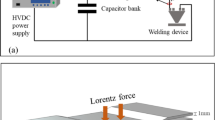Abstract
To solve the problem of energy loss caused by low energy utilization rate in the process of magnetic pulse welding (MPW), this paper presents a method to recover the energy after the first half wave of pulse current by using auxiliary capacitance. A detailed introduction of the working process of the improved discharge circuit was first carried out. Then experimental investigation of the current waveform of the main discharge circuit and analyzed numerically of the improved MPW system were investigated. The experimental results of the current waveform of the main discharge loop agree well with the simulation results, which verifies the feasibility of the proposed method. The simulation results show that the energy loss decreases from 95.3% before the improvement to 36% after the improvement, and the energy utilization rate increases by 261.5%. According to the welding window theory, the welding quality of this method is the same as that of the traditional method. It shows that this method can greatly improve the energy utilization rate of magnetic pulse welding without reducing the welding quality and verifies the effectiveness of this method.













Similar content being viewed by others
References
Taban E, Gould JE, Lippold JC (2010) Characterization of 6061–T6 aluminum alloy to AISI 1018 steel interfaces during joining and thermo-mechanical conditioning. Mater Sci Eng A 527:1704–1708. https://doi.org/10.1016/j.msea.2009.10.059
Torkamany MJ, Tahamtan S, Sabbaghzadeh J (2010) Dissimilar welding of carbon steel to 5754 aluminum alloy by Nd:YAG pulsed laser. Mater Des 31:458–465. https://doi.org/10.1016/j.matdes.2009.05.046
Yan YB, Zhang ZW, Shen W, Wang JH, Zhang LK, Chin BA (2010) Microstructure and properties of magnesium AZ31B–aluminum 7075 explosively welded composite plate. Mater Sci Eng A 527:2241–2245. https://doi.org/10.1016/j.msea.2009.12.007
Fuller CB, Mahoney MW, Calabrese M, Micona L (2010) Evolution of microstructure and mechanical properties in naturally aged 7050 and 7075 Al friction stir welds. Mater Sci Eng A 527:2233–2240. https://doi.org/10.1016/j.msea.2009.11.057
Atasoy E, Kahraman N (2008) Diffusion bonding of commercially pure titanium to low carbon steel using a silver interlayer. Mater Charact 59:1481–1490. https://doi.org/10.1016/j.matchar.2008.01.015
Liu J, Watanabe I, Yoshida K, Atsuta M (2002) Joint strength of laser-welded titanium. Dent Mater 18:143–148. https://doi.org/10.1016/S0109-5641(01)00033-1
DebRoy T, David SA (1995) Physical processes in fusion welding. Rev Mod Phys 67:85–112. https://doi.org/10.1103/RevModPhys.67.85
Kang B-Y (2015) Review of magnetic pulse welding. J Weld Join 33:7–13. https://doi.org/10.5781/JWJ.2015.33.1.7
Wang H, Wang Y (2019) High-velocity impact welding process: a review. Metals 9:144. https://doi.org/10.3390/met9020144
Li Z, Peng W, Chen Y, Liu W, Zhang H (2023) Analysis of energy transfer process in magnetic pulse welding and optimization of system efficiency. Int J Adv Manuf Technol 125:2425–2434. https://doi.org/10.1007/s00170-023-10905-4
Khalil C, Marya S, Racineux G (2020) Magnetic pulse welding and spot welding with improved coil efficiency—application for dissimilar welding of automotive metal alloys. J Manuf Mater Process 4:69. https://doi.org/10.3390/jmmp4030069
Zhang H, Yang Z, Ren L (2019) Experimental investigation on structure parameters of E-shaped coil in magnetic pulse welding. Mater Manuf Processes 34:1701–1709. https://doi.org/10.1080/10426914.2019.1689263
Deng F, Cao Q, Han X, Li L (2018) Electromagnetic pulse spot welding of aluminum to stainless steel sheets with a field shaper. Int J Adv Manuf Technol 98:1903–1911. https://doi.org/10.1007/s00170-018-2208-2
Li C, Zhou Y, Wang X, Shi X, Liao Z, Du J, Yao C (2020) Influence of discharge current frequency on electromagnetic pulse welding. J Manuf Process 57:509–518. https://doi.org/10.1016/j.jmapro.2020.06.038
Li Z, Peng W, Chen Y, Liu W, Zhang H (2022) Simulation and experimental analysis of Al/Ti plate magnetic pulse welding based on multi-seams coil. J Manuf Process 83:290–299. https://doi.org/10.1016/j.jmapro.2022.09.015
Zhou Y, Li C, Shi X, Wang P, Shen T, Mi Y, Ma Y (2022) Evaluation model of electromagnetic pulse welding effect based on Vc-β trajectory curve. J Market Res 20:616–626. https://doi.org/10.1016/j.jmrt.2022.07.069
Carpenter SH, Wittman RH (1975) Explosion welding. Annu Rev Mater Sci 5:177–199. https://doi.org/10.1146/annurev.ms.05.080175.001141
Groche P, Becker M, Pabst C (2017) Process window acquisition for impact welding processes. Mater Des 118:286–293. https://doi.org/10.1016/j.matdes.2017.01.013
HoseiniAthar MM, Tolaminejad B (2015) Weldability window and the effect of interface morphology on the properties of Al/Cu/Al laminated composites fabricated by explosive welding. Mater Des 86:516–525. https://doi.org/10.1016/j.matdes.2015.07.114
AkbariMousavi SAA, Al-Hassani STS (2008) Finite element simulation of explosively-driven plate impact with application to explosive welding. Mater Des 29:1–19. https://doi.org/10.1016/j.matdes.2006.12.012
Funding
This work was supported by the National Natural Science Foundation of China (Grant numbers 51877014).
Author information
Authors and Affiliations
Contributions
All authors contributed to the study conception and design. Material preparation, data collection, and analysis were performed by Wentao Liu, Wenxiong Peng, Zhi Li, and Huaiqing Zhang. The first draft of the manuscript was written by Wentao Liu, and all authors commented on previous versions of the manuscript. All authors read and approved the final manuscript.
Corresponding author
Ethics declarations
Competing interests
The authors declare no competing interests.
Additional information
Publisher's Note
Springer Nature remains neutral with regard to jurisdictional claims in published maps and institutional affiliations.
Rights and permissions
Springer Nature or its licensor (e.g. a society or other partner) holds exclusive rights to this article under a publishing agreement with the author(s) or other rightsholder(s); author self-archiving of the accepted manuscript version of this article is solely governed by the terms of such publishing agreement and applicable law.
About this article
Cite this article
Liu, W., Peng, W., Li, Z. et al. Energy efficiency improvement method of magnetic pulse welding based on auxiliary capacitance. Int J Adv Manuf Technol 130, 5869–5878 (2024). https://doi.org/10.1007/s00170-024-13120-x
Received:
Accepted:
Published:
Issue Date:
DOI: https://doi.org/10.1007/s00170-024-13120-x



